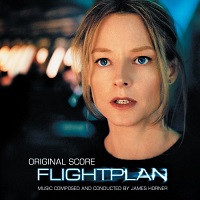- Composed by James Horner
- Hollywood Records / 2005 / 51m
A slick but fairly routine thriller, Flightplan stars Jodie Foster as a woman who falls asleep on a transatlantic flight sitting next to her young daughter, and when she awakens not only finds that her daughter isn’t there any more but that everybody denies having seen her on the flight at all and the crew can find no record of her having been on board. It was the first English-language film directed by Robert Schwentke and was a big hit despite rather mediocre reviews.
At first glance James Horner’s attachment to the film seems a little incongruous (he was rarely scoring this sort of thing any more by this stage of his career) but I guess it was probably the strong emotional arc that Foster’s character goes through that attracted him to it. But despite that, this is not a score where the composer gets to show off his trademark emotional sweep, nor any of his grand dramatic gestures – it’s a taut, tense affair with some interesting colours added to the orchestra and one primary colour (the brass) completely absent.
Horner’s idea here is to musically represent the mental state of Foster’s character: tense, terse, sometimes angry, glimmers of hope coming and going. As was usually the case, he stuck to his guns throughout the score and it works wonders within the film. There are, inevitably, a number of familiar devices on show: the opening moments of the opening cue “Leaving Berlin” move from a rumbling piano through to hit woodblocks and hypnotic winds and could have come from Sneakers many years earlier, or several scores in between. It’s a great scene-setting piece, with an edge to it that makes you want to go and check the doors are locked.
Midway through that opening cue, a piano solo presents the main theme – it’s a simple one, built on a little three-note phrase that moves forward and back, sometimes with a note or two appended to it to signify the state of progress being made. Then in “Missing Child” Horner introduces a secondary theme, this time using the strings to modulate up and down, the tempo continually shifting, with the impression created of thoughts coming and going, desperation building: but he plays against the picture by doing this in a very calmly- and clearly-orchestrated way, not yet allowing it to become overwhelming. When the main theme is heard in this cue, it’s heard on oboe rising above his familiar percussive suspense devices and it’s like a glimmer of light emerging from the gloom.
The ten-minute “The Search” covers a lot of ground. Its opening builds up to the first real action material of the score, nail-bitingly suspenseful action at that. Snares join the strings as they start racing around a little more frantically, but each such burst organically rises from and then falls back to tense percussion (and sometimes splendid impressionistic winds) – often very quickly. The slightly off take on the main theme midway through the cue certainly pushes home the point that there is something seriously awry and almost immediately the composer unleashes more violent orchestral forces (including his ever-glorious crashing piano). When that sequence ends, there is a sense of resignation in the air, variations on the theme seeming to fall away unfulfilled amongst an eerie calm.
“So Vulnerable” perfectly reflects the state of mind its title describes: gossamer thin threads of that central melody, feeling sad and lonely, before another perfectly-titled cue, “Creating Panic”, done with the choppiest strings, percussion and the crashing pianos at full tilt (there are no fewer than eight credited pianists). It’s familiar ground for Horner, sure, but that doesn’t make it any less brilliant. As you might imagine, “Opening the Casket” is not a barrel of laughs – low strings dominate at first, competing melodic lines travelling along for some time before the main theme unexpectedly soars away for the first time in the score.
As the score races to its conclusion, “Carlson’s Plan” presents its most heavy-duty action, intense and at times actually quite dissonant. At the half-way point, there’s a pause and then some very nervous suspense, before a sweepingly dramatic dark melody takes over, full of grit and determination and leading into a version of the main theme embellished with an ethereal hue from synths that’s realised beautifully well. Even here, Horner is playing off the character’s confusion, but for the first time the dark forces are being combated by a hint of heroism. The finale, “Mother and Child”, does not provide the expected Hollywood ending: indeed, it begins with a passage as dark as anything in the score before the main theme begins to emerge. When the rousing fireworks do begin, it never feels forced: on the contrary, it feels earned.
But Horner doesn’t finish the score on that note, instead reducing things down to the bare bones for the second half of the cue, gentle prods from the keyboards perfectly reflecting the emotional wringer everyone’s been taken through. Flightplan is a rarely-mentioned score – but actually a very smart one. It’s not subtle, but it is clever; and while it has a strong, dominant theme (which features in every cue) it’s not one you’re going to be humming on the way to work, so I guess it’s no surprise that it’s not a score that features more prominently in people’s Horner appreciations. I really like it – dramatically vivid, emotionally clever, Horner carefully plots his way through the film and his music offers a similarly compelling narrative away from it.
Rating: ****
facebook.com/moviewave | twitter.com/MovieWaveDotNet | amazon.com













One of my favorite movies. So tense, terrifying and claustrophobic. Horner’s dissonant pianos and otherworldly swirls of piano did so much to evoke the dream-like atmosphere. What a great, great score.